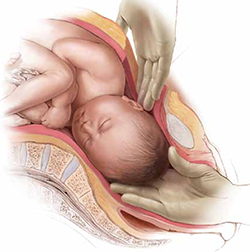Results of a retrospective review. A study of 48 difficult cesarean deliveries reported that the push technique resulted in a higher rate of extensions of the uterine incision (50%) than the pull technique (15%).3
A third retrospective study is relevant. Investigators compared reverse breech extraction and standard direct delivery of the impacted fetal head, without assistance from a vaginal hand. In 182 laboring women in whom the fetal head was deeply impacted, reverse breech extraction was associated with a lower rate of extension of the uterine incision (2%) than the conventional approach of direct delivery of the impacted fetal head (23%).4
My recommendation. When you intend to use a reverse breech delivery technique to deliver a deeply impacted fetal head, I recommend a low vertical uterine incision so that you are able to extend the incision superiorly in case there is difficulty delivering the breech. Many clinicians report, however, that it is relatively easy to perform a reverse breech extraction through a transverse uterine incision.5 If you have made a transverse hysterotomy incision and it becomes difficult to deliver the breech, consider making a J or T incision in the uterus to provide additional room to deliver the breech.

FIGURE 2 Assist from a vaginal hand: The “push technique”
When pushing the head up from the vagina, try to flex the fetal head. If possible, use three or four fingers—or a cupped hand or the palm of the hand—to apply force spread widely across the presenting part.
The “push technique”: An assist from a vaginal hand
Using a hand in the vagina to push the head up toward the uterine incision can be performed by an assistant or the primary surgeon.6 If the need for assistance with a hand from below is recognized before the cesarean is undertaken, the mother’s legs can be placed in a supine frog-leg or modified lithotomy position.7
The assistant pushing the head up from the vagina should try to flex the fetal head. If possible, three or four fingers—or a cupped hand or the palm of the hand—should be used to apply force spread widely across the presenting part.
Caution: Using only one or two fingers for this technique, with the pushing focused on one small area of the head, may increase the risk of fetal skull fracture.
Using the obstetrical spoon
Some clinicians who routinely use a Coyne spoon to deliver the fetal head at the time of cesarean delivery prefer to use the spoon to deliver the deeply impacted fetal head. Using two fingers (not the entire hand), the spoon is gently placed through the uterine incision to a position below the fetal head. The spoon is then used to help release and elevate the head from the pelvis, and the fetus is delivered in the usual manner with the spoon.
Caution: After an excessively prolonged labor, it may be difficult to place the spoon below the fetal head without damaging the lower uterine segment.
Other techniques to consider
When a transverse uterine incision is performed after prolonged labor, a fetal shoulder often appears in the hysterotomy as soon as the incision is made. This so-called shoulder sign is another indication that the fetal head is deeply impacted. Clinicians have reported that it can be helpful to have an assistant gently push the shoulder cephalad, while the surgeon attempts the direct extraction of the fetal head in the classical manner.
A more formal method of using the shoulder that presents in the hysterotomy incision to facilitate delivery has been reported8:
- The shoulder presenting in the hysterotomy is delivered
- The opposite shoulder is delivered
- The fetal body is delivered
- The fetal head is delivered last.
There are risks and consequences to extending the second stage
Trends in OB practice have resulted in more instances of labor in which the second stage extends past 3 hours. Prolonged labor markedly increases the likelihood that an obstetrician will encounter cases in which the fetal head is deflexed and deeply impacted in the pelvis, making extraction of the fetal head very difficult. Prolonged labor also increases the likelihood that the lower uterine segment and upper vagina will be edematous and very thin, increasing the likelihood of trauma to these, and adjacent, organs.
One approach to reduce the risk of difficult fetal extraction is to limit the second stage of labor to 3 hours or less in most situations. If you are asked to perform a cesarean delivery on a patient whose provider has allowed the second stage to extend well beyond 3 hours, be prepared to perform a reverse breech extraction!


